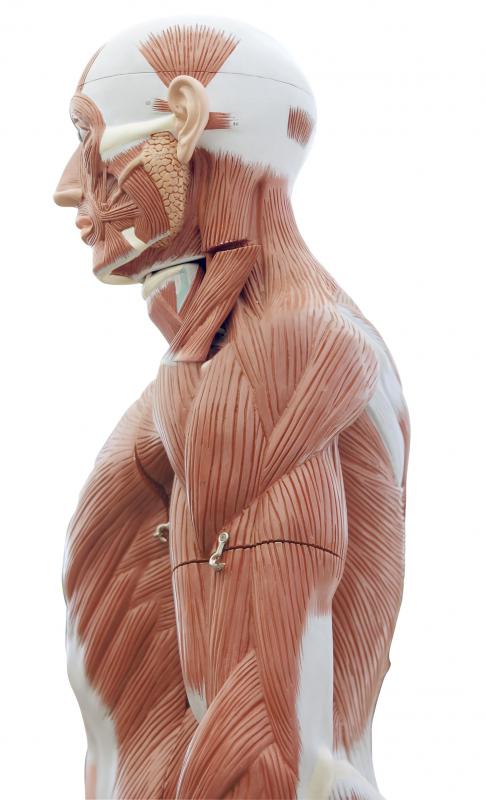At TheHealthBoard, we're committed to delivering accurate, trustworthy information. Our expert-authored content is rigorously fact-checked and sourced from credible authorities. Discover how we uphold the highest standards in providing you with reliable knowledge.
What is the Golgi Tendon Organ?
The Golgi tendon organ is located where muscle fibers of skeletal muscle meet tendons. Made up of strands of collagen, the organ also contains nerve tissue. The major function of this organ is to sense muscle tension when a muscle is contracted, sending signals to the brain about how much force is being exerted and where. This important sensory organ was discovered by and named after Camillo Golgi, an Italian physician who made numerous discoveries about the function of the human nervous system in the late 19th and early 20th centuries.
Classified as a proprioceptive sensory receptor, the Golgi tendon organ belongs to a family of structures that send information to the brain about how joints are functioning, including the angles at which they are held, the length of the muscle at any given time and how much tension is placed on the joint or the muscle. Other proprioceptive sensory receptors include muscle spindles.

At one time, it was believed that the Golgi tendon organ responded only to high levels of muscle tension in order to protect muscles from overexertion. These organs do cause a phenomenon known as "weightlifting failure," in which the muscle collapses when the tension exerted is likely to cause damage. The theory that they respond only to high tension is incorrect, though. Studies done in 1967 proved that the Golgi organ responds to all levels of muscle tension, from slight to extreme.

The action of the Golgi tendon organ is of particular interest to weight lifters who wish to steadily increase the amount of weight they can handle. Some believe that forcing the muscles to do additional repetitions on very heavy weights could actually "train" the muscles to fail in future lift attempts. Others believe, and some research indicates, that this is not likely, because of the way the Golgi tendon organ responds to muscle tension and reports this information to the brain.

In addition to the Golgi tendon organ, Camillo Golgi's name has been attached to a number of other nerve structures that he discovered. Among these are Golgi-Mazzoni corpuscles. Also nerve receptors, Golgi-Mazzoni corpuscles are located in the fingertips and serve to enclose nerve endings in this highly sensitive area of the body. They are found beneath the skin and respond to heat, cold, pressure and other sensory stimuli. Though they are very small, they are complex structures, consisting of connective tissue, nerve cells and protective fluids. Similar structures elsewhere in the body are referred to as Pacinian corpuscles.
AS FEATURED ON:
AS FEATURED ON:














Discussion Comments
This is not the golgi tendon organ in the reflex, it is the muscle spindle which is connected to the alpha motor neuron which elicits the reflex and a consequent reciprocal inhibitory relaxation on the ipsilateral muscle.
GTO is concerned with tension and only relaxes muscles when the tension is too much. It is not associated with any stretch reflex.
(Post3 is correct.)
@Artyest: The golgi tendon reflex is to prevent excessive stresses at joints by reflex inhibition of the adjacent muscles. If the strain on the muscle and tendon becomes excessive, the Golgi tendon organ sends an impulse via afferent neurons to the CNS, where they synapse with motor neuron fibers of that same muscle. The efferent neurons instantly transmit an impulse to the muscle, causing it to relax, thereby preventing injury.
@artyest - The golgi tendon organ is stretching between the muscle and the tendon. It forms the junction. The arc describes the process of stretch reflex. When the golgi organ pulls on the muscle and tendon, the tendom reflex occurs because the spinal cord, and then from the spinal cord back to the muscle belly. This is the reflex arc.
OK, so I get that the golgi tendon organ functions during stretching. But I can't remember the specific details of the golgi tendon reflex arc? I have to do a project on this for my bio 101 class, and I'm just having a hard time wrapping my head around this. Can anybody help me out?
Post your comments